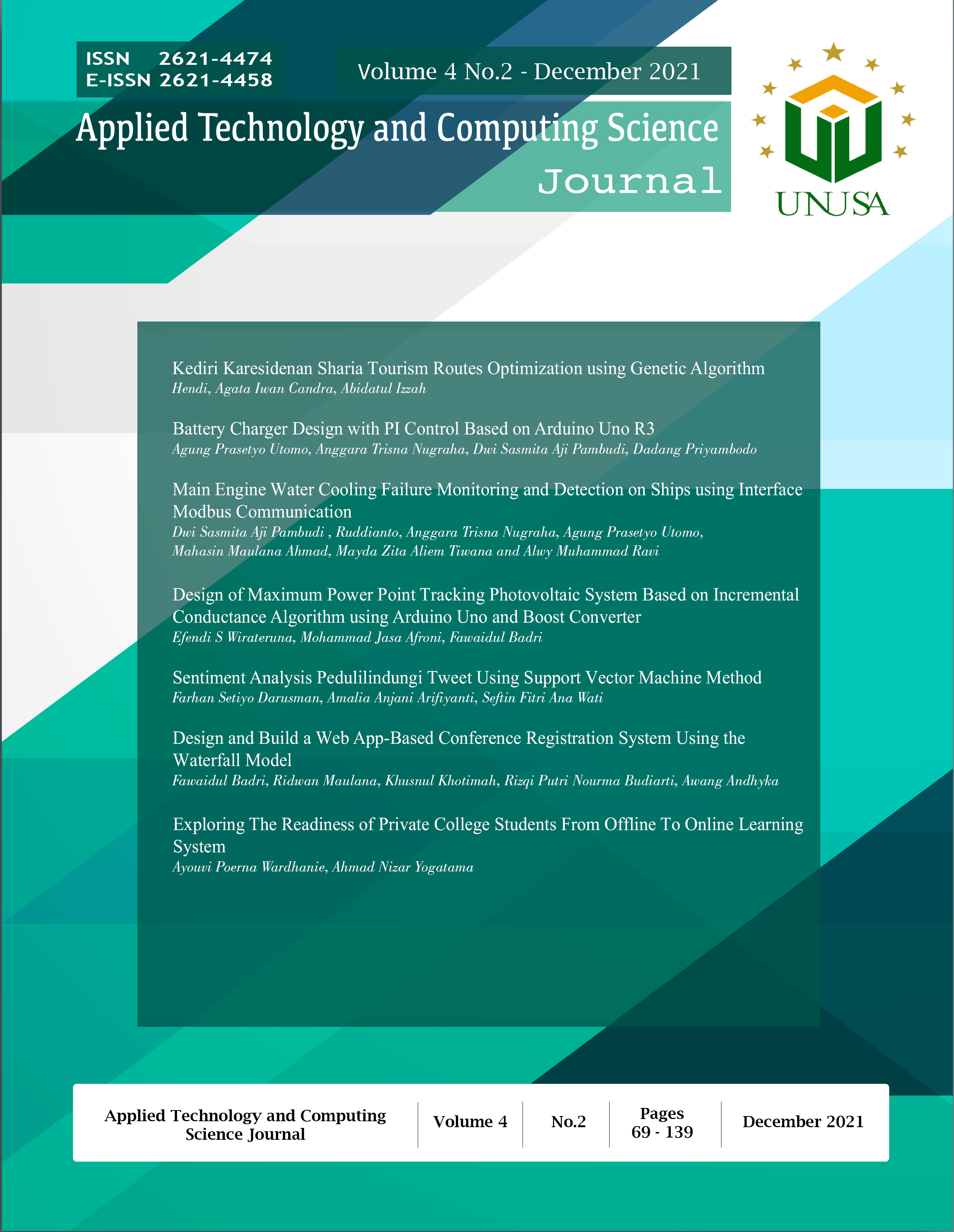Kediri Karesidenan Sharia Tourism Routes Optimization using Genetic Algorithm
Main Article Content
Abstract
Sharia tourism is a tour from nature, culture, or artificial tourism framed by Islamic values, which provides a sense of security and comfort. East Java, one of the thirteen provinces prepared by Indonesia to become a sharia tourism destination, has an excellent opportunity to be developed. One of them is Kediri Karesidenan. There are 154 destinations that can be explored and considered as sharia tourist destinations in Kediri Karesidenan. There has been no research that discusses sharia travel routes, as well as the need for government to develop sharia tourism in Indonesia, making this research very important to do. In planning the development of effective and efficient transportation routes, which reach sharia tourist destinations in Kediri Karesidenan, scientific and technological contributions are needed. A genetic algorithm is an alternative solution to searching and optimization problems. In this research, the genetic algorithm is used to determine the shortest route to reach sharia tourist destinations in five areas in Kediri Karesidenan, such as Kediri, Nganjuk, Blitar, Tulungagung, and Trenggalek. The conclusion is the length of the sharia tourism route in Kediri, Nganjuk, Blitar, Tulungagung, Trenggalek, respectively, are 249.32 km, 289.148 km 452.95 km, 341.68 km, 384.67 km. In addition, the authors used the K-means clustering algorithm to group sharia tourist destinations in Kediri Karesidenan, basic on four properties, namely: the city where the destination is located, the type of tourism, the price of admission, and the distance of the destination with the city center. It can be concluded that the best value of K is K=3, and in each resulting cluster, the authors apply the genetic algorithm to determine the shortest sharia tourism route.
Downloads
Article Details
Copyright (c) 2022 Hendy, Agata Iwan Candra, Abidatul Izzah

This work is licensed under a Creative Commons Attribution-ShareAlike 4.0 International License.
References
S. Razzaq, C. M. Hall, and G. Prayag, "The capacity of New Zealand to accommodate the halal tourism market - Or not," Tour. Manag. Perspect., vol. 18, pp. 92–97, 2016, doi: 10.1016/j.tmp.2016.01.008.
J. Junaidi, A. Suci, S. T. Nanda, and B. Kadaryanto, "Halal-friendly tourism business process: Tourism operators in Indonesia," Geoj. Tour. Geosites, vol. 27, no. 4, pp. 1148–1157, 2019, doi: 10.30892/gtg.27403-422.
S. Perbawasari, D. W. Sjuchro, Y. Setianti, A. R. Nugraha, and I. Muda, “Halal tourism communication formation model in west Java, Indonesia,” Geoj. Tour. Geosites, vol. 25, no. 2, pp. 309–320, 2019, doi: 10.30892/gtg.25203-361.
D. Valeriani, Hidayati, M. Yusnita, and A. Wulandari, "Potential of Bangka belitung tourism towards the world Halal tourism award through tourist perception with SWOT analysis," J. Crit. Rev., vol. 7, no. 6, pp. 1093–1098, 2020, doi: 10.31838/jcr.07.06.190.
I. Izwar, B. Badaruddin, M. B. Mulya, and R. Sibarani, “Potential of Reusam Island to become sharia ecotourism area,” Geoj. Tour. Geosites, vol. 30, no. 2, pp. 827–834, 2020, doi: 10.30892/gtg.302spl07-511.
Hendy, A. N. Mudholifah, K. A. Sugeng, M. Bača, and A. Semaničová-Feňovčíková, “On H-antimagic decomposition of toroidal grids and triangulations,” AKCE Int. J. Graphs Comb., vol. 0, no. 0, pp. 1–10, 2020, doi: 10.1016/j.akcej.2019.09.006.
H. Hendy, K. A. Sugeng, A. N. . Salman, and N. Ayunda, "Another H-super magic decompositions of the lexicographic product of graphs," Indones. J. Comb., vol. 2, no. 2, p. 72, 2018, doi: 10.19184/ijc.2018.2.2.2.
S. Saud, H. Kodaz, and İ. Babaoğlu, "Solving Travelling Salesman Problem by Using Optimization Algorithms," KnE Soc. Sci., vol. 3, no. 1, p. 17, 2018, doi: 10.18502/kss.v3i1.1394.
N. Chandekar and M. J. Pillai, "in A Comparative Study of GA and ACO for Solving Travelling Salesman Problem A COMPARATIVE STUDY OF GA AND ACO FOR SOLVING TRAVELLING SALESMAN PROBLEM," Int. J. Mech. Prod. Eng., no. 5, pp. 2320–2092, 2017, [Online]. Available: http://iraj.
E. L. Bouzarth et al., "A comparison of algorithms for finding an efficient theme park tour," J. Appl. Math., vol. 2018, pp. 16–18, 2018, doi: 10.1155/2018/2453185.
X. Chen, Y. Liu, X. Li, Z. Wang, S. Wang, and C. Gao, "A New Evolutionary Multiobjective Model for Traveling Salesman Problem," IEEE Access, vol. 7, pp. 66964–66979, 2019, doi: 10.1109/ACCESS.2019.2917838.
A. C. Cinar, S. Korkmaz, and M. S. Kiran, "A discrete tree-seed algorithm for solving symmetric traveling salesman problem," Eng. Sci. Technol. an Int. J., vol. 23, no. 4, pp. 879–890, 2020, doi: 10.1016/j.jestch.2019.11.005.
Abidatul Izzah, B. A. Nugroho, W. F. Mahmudy, and F. A. Bachtiar, “Optimasi Asymmetric City Tour di Kota Kediri Menggunakan Ant Colony System,” J. Nas. Tek. Elektro dan Teknol. Inf., vol. 9, no. 1, pp. 1–7, 2020, doi: 10.22146/jnteti.v9i1.112.
O. Mohammadrezapour, O. Kisi, and F. Pourahmad, "Fuzzy c-means and K-means clustering with genetic algorithm for identification of homogeneous regions of groundwater quality," Neural Comput. Appl., vol. 32, no. 8, pp. 3763–3775, 2020, doi: 10.1007/s00521-018-3768-7.
M. A. El-Shorbagy, A. Y. Ayoub, A. A. Mousa, and I. M. El-Desoky, An enhanced genetic algorithm with new mutation for cluster analysis, vol. 34, no. 3. Springer Berlin Heidelberg, 2019.
S. Wang et al., "K-Means Clustering With Incomplete Data," IEEE Access, vol. 7, pp. 69162–69171, 2019, doi: 10.1109/ACCESS.2019.2910287.
K. P. Sinaga and M. S. Yang, "Unsupervised K-means clustering algorithm," IEEE Access, vol. 8, pp. 80716–80727, 2020, doi: 10.1109/ACCESS.2020.2988796.
Q. Jin, N. Lin, and Y. Zhang, "K-means clustering algorithm based on chaotic adaptive artificial bee colony," Algorithms, vol. 14, no. 2, 2021, doi: 10.3390/a14020053.

